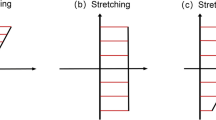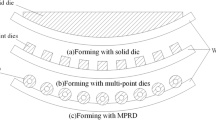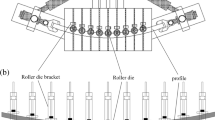Abstract
Springback compensation is considered as the best method to reduce springback error. In view of the springback defect of 3D deformed workpiece, a springback compensation method based on variable compensation factor is proposed. This method can accelerate the convergence speed of iterative compensation. In this paper, the 3D flexible stretch bending of multi-point roller die technology (3D FSB-MPRD) is introduced firstly, and then, the principle of the springback compensation method based on variable compensation factor is explained. In order to improve the springback compensation accuracy of workpiece, the total springback compensation process is divided into horizontal bending springback compensation and vertical bending springback compensation. Taking the T-shaped profile with variable curvature as the research object, the die surface is optimized and the optimal springback compensation factor is obtained by using numerical simulation after multiple iterations. Finally, the results of springback compensation are compared with the desired shape. And the effectiveness of the springback compensation method based on variable compensation factor is verified by comparing the simulation results with the test results.














Similar content being viewed by others

References
Santos AD, Duarte JF, Reis A, Rocha B, Neto R, Paiva R (2001) The use of finite element simulation for optimization of metal forming and tool design. J Mater Process Technol 119:152–157
Meinders T, Burchitz IA, Bonte MHA, Lingbeek RA (2008) Numerical product design: springback prediction, compensation and optimization. Int J Mach Tools Manuf 48:499–514
Xu SG, Zhao KM, Lanker T, Zhang J, Wang CT (2005) Springback prediction, compensation and correlation for automotive stamping. Aip Conf Proc 778:345–350
Ma R, Wang CG, Zhai RX, Zhao J (2019) An iterative compensation algorithm for springback control in plane deformation and its application. Chin J Mech Eng 32:1–12
Hindman C, Ousterhout KB (2000) Developing a flexible sheet forming system. J Mater Process Technol 99:38–48
Badr OM, Rolfe B, Zhang P, Weiss M (2017) Applying a new constitutive model to analyse the springback behaviour of titanium in bending and roll forming. Int J Mech Sci 128:389–400
Dang VT, Labergere C, Lafon P (2018) Adaptive metamodel-assisted shape optimization for springback in metal forming processes. Int J Mater Form 1:1–18
Zhai RX, Ding XH, Yu SM, Wang CG (2018) Stretch bending and springback of profile in the loading method of prebending and tension. Int J Mech Sci 144:746–764
Papeleux L, Ponthot JP (2002) Finite element simulation of springback in sheet metal forming. J Mater Process Technol 125:785–791
Lei LP, Hwang SM, Kang BS (2001) Finite element analysis and design in stainless steel sheet forming and its experimental comparison. J Mater Process Technol 110:70–77
Karafillis AP, Boyce MC (1992) Tooling design accomodating springback errors. J Mater Process Technol 32:499–508
Karafillis AP, Boyce MC (1992) Tooling design in sheet metal forming using springback calculations. Int J Mech Sci 34:113–131
Karafillis AP, Boyce MC (1996) Tooling and binder design for sheet metal forming processes compensating springback error. Int J Mach Tool Manu 36:503–526
Gan W, Wagoner RH (2004) Die design method for sheet springback. Int J Mech Sci 46:1097–1113
Gan W, Wagoner RH, Mao K, Price S, Rasouli F (2004) Practical methods for the design of sheet formed components. J Eng Mater Technol ASME 126:360–367
Lingbeek R, Huetink J, Ohnimus S, Petzoldt M, Weiher J (2005) The development of a finite elements based springback compensation tool for sheet metal products. J Mater Process Technol 169:115–125
Lingbeek RA, Huetink J, Ohnimus S, Weiher J (2005) Iterative springback compensation of NUMISHEET benchmark #1. Aip Conf Proc 778:328–333
Weiher J, Rietman B, Kose K, Ohnimus S, Petzoldt M (2004) Controlling springback with compensation strategies. Materials Processing and Design: Modeling, Simulation and Applications, Pts 1 and 2 712:1011-1015
Lingbeek RA, Gan W, Wagoner RH, Meinders T, Weiher J (2008) Theoretical verification of the displacement adjustment and springforward algorithms for springback compensation. Int J Mater Form 1:159–168
Yang XA, Ruan F (2011) A die design method for springback compensation based on displacement adjustment. Int J Mech Sci 53:399–406
Jia BB, Wang WW (2017) New process of multi-point forming with individually controlled force-displacement and mechanism of inhibiting springback. Int J Adv Manuf Technol 90:3801–3810
Zhang QF, Cai ZY, Zhang Y, Li MZ (2013) Springback compensation method for doubly curved plate in multi-point forming. Mater Des 47:377–385
Liang JC, Gao S, Teng F, Yu PZ, Song XJ (2014) Flexible 3D stretch-bending technology for aluminum profile. Int J Adv Manuf Technol 71:1939–1947
Gao S, Liang JC, Li Y, Hao ZP, Li QH, Fan YH, Sun YL (2018) Precision forming of the 3D curved structure parts in flexible multi-points 3D stretch-bending process. Int J Adv Manuf Technol 95:1205–1213
Funding
This work was financially supported by the Project of Jilin Provincial Scientific and Technological Department (20190302037GX, 20190201110JC), Project of Jilin Provincial Development and Reform Commission (2019C046-2), and the Project of Education Department of Jilin Province (JJKH20180943KL).
Author information
Authors and Affiliations
Corresponding authors
Ethics declarations
Conflict of interest
The authors declare that they have no conflicts of interest.
Additional information
Publisher’s note
Springer Nature remains neutral with regard to jurisdictional claims in published maps and institutional affiliations.
Rights and permissions
About this article
Cite this article
Chen, C., Liang, J., Teng, F. et al. Research on springback compensation method of 3D flexible stretch bending of multi-point roller dies. Int J Adv Manuf Technol 112, 563–575 (2021). https://doi.org/10.1007/s00170-020-06326-2
Received:
Accepted:
Published:
Issue Date:
DOI: https://doi.org/10.1007/s00170-020-06326-2



